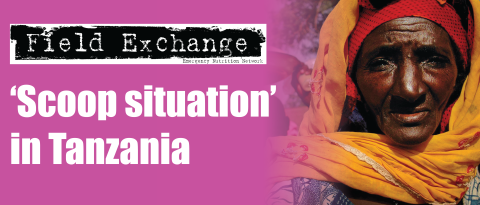Assessing micronutrient deficiencies in emergencies
Summary of review1

Field haemoglobin testing using a hemacue machine
Micronutrient deficiencies have been reported for years in emergency settings, especially in refugee camps where they were most frequently assessed. However, assessments have remained scarce, with less than 10% of anthropometric nutrition surveys reported in the Nutrition Information in Crisis Situations (NICS)2 bulletin in 2005-6 having a micronutrient assessment component. Anaemia, measured by blood haemoglobin concentration, and clinical vitamin A deficiency were the main deficiencies investigated.
A recent review published by the Standing Committee on Nutrition (SCN) explores options available for investigating micronutrient deficiencies. It draws attention to best practices and includes references to practical tools and guidelines. It begins with the premise that when investigating micronutrient deficiency disease (MNDD), it should be remembered that clinical signs will usually only be the tip of the iceberg. Beneath this a much greater burden of sub-clinical deficiency will almost always be found. Two main approaches to investigate micronutrient deficiency disease are used:
- Indirect assessment that involves estimation of nutrient intakes at population level and extrapolating risk of deficiency and likely prevalence and public health seriousness of MNDD.
- Direct assessment involving measurement of clinical or sub-clinical deficiency in individuals and using information to estimate population prevalence of MNDD.

Premxing fortified food in Zambia
The review highlights a number of recent initiatives and resources to improve field practice, e.g. World Health Organisation (WHO) reviews, field manuals by the Centre for Disease Classification (CDC) and the Micronutrient Initiative (MI) and SPHERE project manuals. However the reviewers argue that many gaps exist in our knowledge of how to assess micronutrient deficiencies and how to react to the information collected.
The main conclusions of the SCN review are as follows;
Further improvements in field friendly techniques for assessment are needed. Using direct collection and storage of liquid serum and urine remain a more reliable method of sample collection than blood spots, but more work on sample collection and storage is needed to make field surveys easier to conduct in remote locations.
The increasing introduction of micronutrientfortified foods in food rations (especially blended food) since the mid-nineties, has probably helped to prevent a number of major micronutrient outbreaks. However, outbreaks have continued to arise. The review suggests that a combination of responses may be appropriate, namely increasing access to fresh food, improving livelihoods and access to markets, enhanced fortification of food items of the general food distribution, distribution of pills, and home-based fortification with micronutrient powders or fortified condiments are some of the alternatives3.
For the rapid design of nutritionally adequate rations at minimum cost, linear programming and other mathematical optimisation techniques can be important tools. They can take into account constraints like dietary practices and food costs in developing diets that meet nutrient recommendations and can be used to model the worst and best case scenarios to more reliably determine risk of deficiency. They can also be used to assess the economic value of fortified food supplements. Implementation of these approaches in easy-to-use software tools could lead to dramatic improvements in the nutritional quality of rations and a reduction in costs. However, they have seldom been used in emergency contexts to date.

A case of Casals necklace (pellagra) in Angola
In the absence of fortification or supplementation, diets need to be diversified and balanced. However, it has proven difficult to distribute fresh, perishable foods on a large scale due to logistic constraints. Some small-scale successful home gardening programmes have been reported, but their impact on nutrient intake was not investigated.
Fortification of food aid commodities may be achieved at different stages of the logistic pathway. Guidelines on food fortification have been recently released by WHO and initiatives to increase the fortification of foods within developing countries continue to expand.
While pill distribution has been useful in preventing/treating MNDD in the short-term, longterm supplementation might be less sustainable. Maintaining a distribution network to serve the whole population and ensuring adherence and safe use by different population sub-groups would also be a major challenge for health and nutrition agencies.
Home based fortification using a micronutrient powder, highly fortified paste or sauce has been increasingly used in programmes. However, published evidence on its use in emergencies is still scarce. A large-scale distribution of a micronutrient powder to children aged 6 months to 12 years in families displaced by the Tsunami was successfully implemented in Aceh and Nias provinces of Indonesia in 2005-6, but no data on nutritional impact has been reported.
A number of issues related to supplementation persist, e.g. the potential toxicity of supplementing children with iron in malarious areas if supplementation is targeted at the whole population rather than those known to be iron deficient. There is also uncertainty, and therefore the need for caution regarding the use of micronutrient powders in home fortification.
The authors conclude that efforts to improve the micronutrient status of populations in emergency situations should continue and be given priority as a major public health issue.
1SCN (2007). Assessing micronutrient deficiencies in emergencies: Current practice and future directions. Supplement by Andrew Seal and Claudine Prudhon October 2007. Standing Committee on Nutrition (SCN), Geneva, Switzerland.
2See online at http://www.unsystem.org/SCN/Publications/html/rnis.html
3Exclusive breastfeeding for infants under six months and continued breastfeeding is another significant and recognised means to protect micronutrient status of infants and young children. See news piece this issue of Field Exchange on WHO/UNICEF Joint Statement on micronutrient deficiencies in emergencies (p18). (eds)
Imported from FEX website


